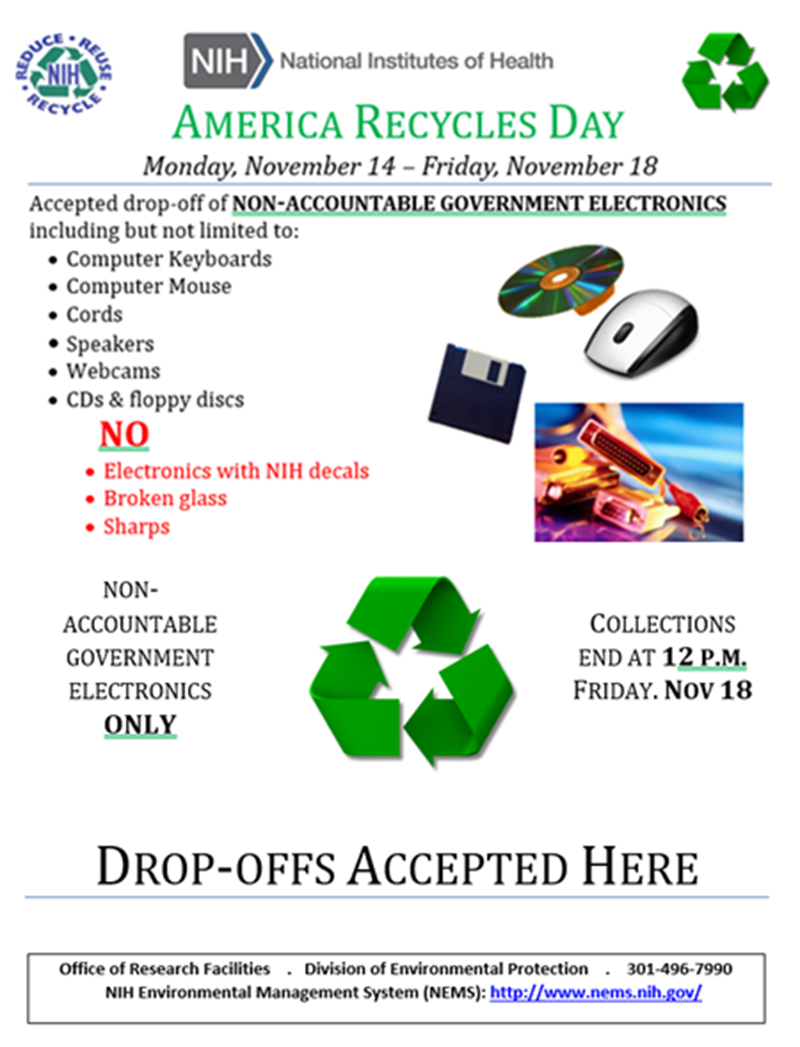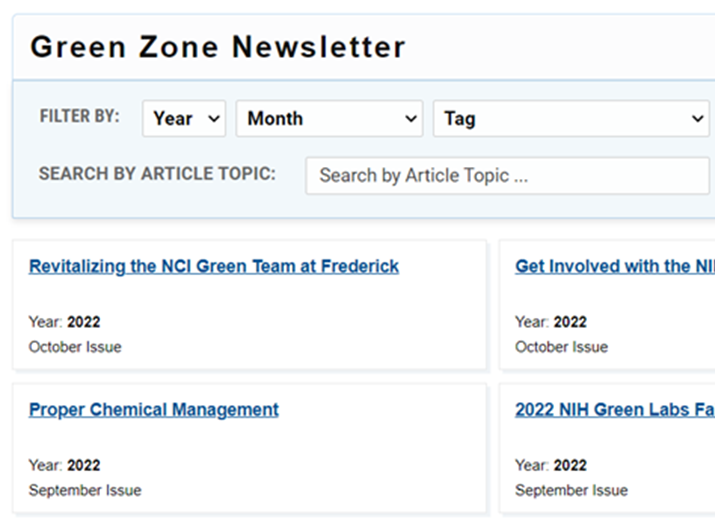
SUBSCRIBE PREVIOUS ISSUES
Take Action
NIH Waste and Recycling Programs in 2022
The waste and recycling programs for the NIH frequently change to fit the needs of NIH staff. The Waste and Resource Recovery Branch [within the Division of Environmental Protection (DEP)] is responsible for the supervision, management and conduct of the waste management program at the NIH. This group has released many new or redesigned waste and recycling programs in 2022, most of which have been featured in previous newsletter issues. To make the information on these programs easier to locate, this article contains a consolidated list of the waste and recycling programs from 2022. Please contact DEP (301-496-7990) for assistance with waste and recycling or any of these waste management programs.
- Styrofoam Take Back Program - The Styrofoam Take Back Program was re-started to collect and reuse Styrofoam packaging products. Collection bins are available for each building on the Bethesda campus. Please contact DEP at 301-496-7990 to request a collection bin or to learn where a bin is already located. DEP, in collaboration with the scientific community, is seeking eco-friendly Styrofoam alternatives. Please visit the Styrofoam Alternatives Microsoft Teams Channel to view, post and discuss alternatives to Styrofoam coolers.
- Compost Program – The Waste and Resource Recovery Branch (WRRB), in partnership with Montgomery County, has implemented a pre-consumer food scrap composting program in the Building 10 cafeterias on the Bethesda campus. This composting program was initiated to reduce the amount of waste buildup in landfills, reduce greenhouse gas emissions, protect our environment and help achieve the DEP goal of zero waste. The collected food scraps are transported to the Prince George’s County Western Branch Organics Composting Facility in Upper Marlboro, MD where they are processed into a beneficial soil amendment. To learn more about this program, please contact DEP (301-496-7990).
- Medical Waste Totes Program - WRRB has implemented a new Medical Waste Totes program for NIH animal facilities which allows for collecting a larger volume of medical pathological waste (MPW). This change has led to a reduction in the frequency of waste collection pickups. In addition, this program provides a cost savings through the elimination of MPW box purchases, as well as incineration cost savings via reduced MPW weight. Please contact DEP (301-496-7990) for more information.
- Chemical Waste Compliance Poster - DEP has designed a chemical waste compliance poster to inform NIH staff on proper chemical waste management. The goal of this initiative is to avoid significant fines due to non-compliance findings for chemical waste management. NIH staff need to display this poster in all areas that generate chemical waste. The poster provides information on compliance with the NIH chemical waste tag, chemical waste containers and the top compliance issues found in laboratories. Over 2,000 posters will arrive by the new year (2023) to be distributed throughout the NIH Community. More information on obtaining these posters will be provided once they are available.
- Recycling Coordinator Sessions - Recycling Coordinator Sessions were established to provide an outlet for recycling education and information, such as NIH guidelines and resources available to staff.
- NIH Chemical Waste Tag – The NIH Chemical Waste Tag was redesigned to address regulatory changes. The tag was last revised in 1993 and at the time was reformatted and modified while retaining many aspects of the old tag. The new tag includes pictograms derived from the Global Harmonized labeling system to easily identify hazards. Explanations of hazards, with examples of chemicals commonly found within the laboratory, were added to the new tag to assist with compliance. Step-by-step instructions for completing the new tag can be found here.
- NIH Drain Discharge Guide – WRRB, the Scientific Directors and NIEHS leadership coordinated to develop a guide on what is permitted go down the drain, as part of a larger, comprehensive waste management strategy. This policy outlines over 275 chemicals that are approved for drain disposal along with an 8-step safety protocol that must be followed when performing this action.
- Application for Disposal of Specific Chemical Reagents to the Sanitary Sewer - In coordination with the Drain Discharge Guide, the IT application software used to submit and approve drain disposal applications to the sanitary sewer was redesigned. This was done to address the limited need for the disposal of specific liquid chemical waste to the sanitary sewer.
- NIH Drain Discharge Guide Outreach - Several posters and decal stickers were developed for placement above laboratory sinks to promote the NIH Drain Discharge Guide. To obtain posters or decal stickers, please contact Craig Upson.
Featured Article

| 2022 America Recycles Day
America Recycles Day is the only nationally-recognized day dedicated to promoting recycling in the United States. In this article, we describe activities for America Recycles Day at the NIH.
LEARN MORE
|
Spotlight

| Check out the NIH Green Zone Newsletter Archive!
The NIH Green Zone Newsletter webpage has been improved to include a searchable archive. Past articles can now be filtered or searched using various criteria to find exactly the article you're looking for!
LEARN MORE
|
NEMS Training
Did you know? Accountable government property must be disposed through your Property Accountability Officer (PAO). To learn more about waste management at the NIH, please visit the NEMS Training webpage to view a short (20 minute) NIH environmental awareness training video.
The NIH Green Zone Newsletter is a publication intended to inform NIH staff about the Division of Environmental Protection and NIH Green Teams projects and initiatives. The text contained in this newsletter is not copyrighted and can be reprinted without permission. If you use portions of this newsletter in your own publication, we ask that you please credit the source. We welcome your comments and suggestions. Thank you.
|
|---|
| Division of Environmental Protection | Office of Research Facilities | Office of Management
National Institutes of Health | U.S. Department of Health and Human Services
|